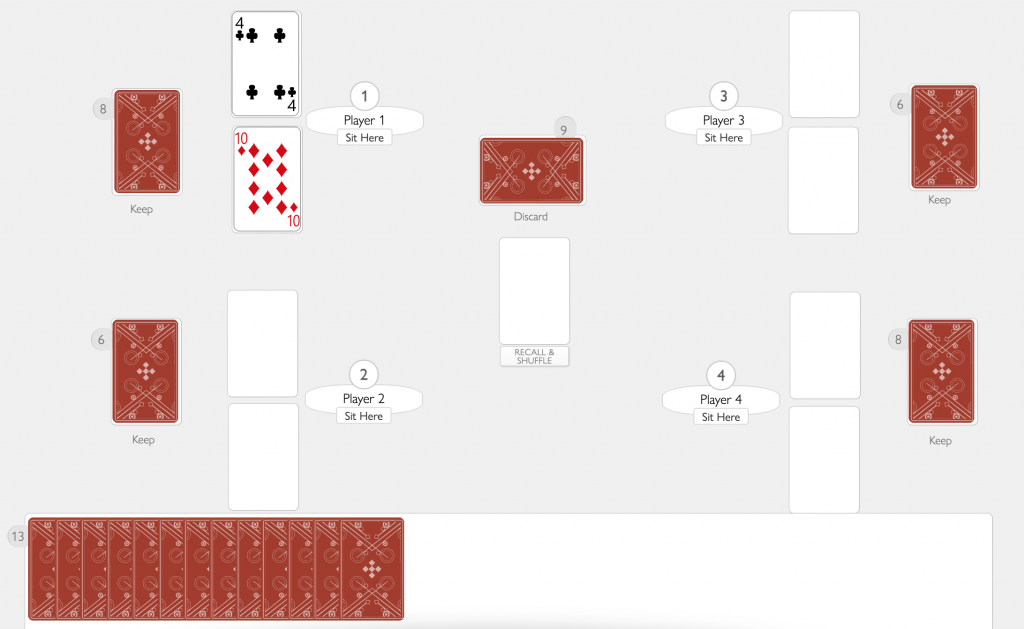Fraction Action
Junior (Age 9 – 12)
Curriculum Goal
Junior: Number Sense
- Represent equivalent fractions from halves to twelfths, including improper and mixed numbers, in various contexts.
- Compare and order fractions from halves to twelfths, including improper fractions and mixed numbers, in various contexts.
Context
- Two to four students and the teacher.
- Students should have previous experience with creating and comparing fractions.
Materials
In-person version
- One standard 52-card deck
- Action cards (Appendix A)
Online version
- Game file (Playingcards.io upload instructions)
- Video conference capabilities
Lesson
- The goal of the game is to win as many cards as possible.
- Deal out entire deck of cards equally among students.
- Number cards hold their value, Aces equal one, Kings and Queens are 10, and Jacks and Jokers are wild cards.
- Students take turns flipping over the top two cards from their pile to create a fraction. The first drawn card is the numerator, and the second drawn card is the denominator.
- The student compares their created fraction to 1/2.
- If the fraction is less than 1/2, the student keeps their cards in a separate ‘cards won’ pile.
- If the fraction is greater than 1/2, the student places their cards in the discard pile.
- If the student creates a fraction that is equal to 1/2 or 1, the player keeps their fraction cards and wins the discard pile to add to their ‘cards won’ pile.
- If there is an improper fraction, the player estimates the whole number value closest to the improper fraction and gives that many cards to the player to the left.
- If one of the cards in the created fraction is a wild card, the player chooses any number from one to ten to create a fraction that can win them as many cards as possible.
- The game ends when all students do not have any more cards in their pile. The player with the most cards in their ‘cards won’ pile wins.

Look Fors
- What strategies do the children implement to determine the fraction’s magnitude compared to 1/2 or 1? For example, do children picture a fraction’s magnitude on a number line? Do they use drawings to figure out the fraction’s magnitude?
- How fluently do children determine the approximate value of the fraction in relation to 1/2 and 1 whole?
- Can children determine equivalent fractions to 1/2 or 1?
- Can children estimate the closest whole number value of an improper fraction?
- Do children strategically choose a wild-card number value to help them win the maximum number of cards?
Extension
- Set a condition on using the wild cards. For example, limit the players to choosing numbers from one to five, or from five to ten, etc.
- Face cards can count as 11, 12, and 13.
- Add action cards. Each time a player wins a round by getting the closest fraction to a whole or half, they not only win their cards back but also gain an action card. Some examples of action cards are:
- Block The Collection: Stop an opponent from collecting the discard pile if they lay a half or a whole.
- Keep Your Wholes: If a student has 4/3, once a student converts it to 1 1/3, they can use this card to cancel out the whole number to avoid giving away a card and use 1/3 in the round instead.
- Up to Half: Brings a fraction up to half to claim the discard pile. To use this card, the student must declare what fraction it represents to bring their cards up to half. For example, if the student lays 1/4, they will pair that fraction with this card and say, “this card represents a quarter which, when added to my fraction, brings me up to a half”.
- Up to Whole: Brings a fraction up to a whole to claim the discard pile.
- Steal the Fraction: Played once all fractions are revealed and can be laid to steal the winning fraction for the round. It can be used on any fraction EXCEPT halves and wholes.)
- Fliperator: Enables a player to switch their numerator and denominator to achieve a fraction closer to a half or a whole.
- Tame the Fraction: Limits the numbers the wild card can represent. For example, if 5/WILD CARD is laid, an opponent can play this card and declare the wild card can represent any numbers from one to four. This will stop the player from playing 5/5 or 5/10 to gain a whole or a half.
Created by Sydney MacDougall. Adapted by The Robertson Program.
Share this lesson
Share on facebook
Share on twitter
Share on email
